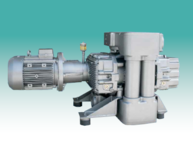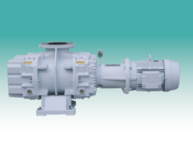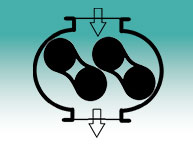Roots pumps
Also: “rotary piston vacuum pumps”
Roots pumps are dry-running vacuum pumps and can pump high volumes. In blower operation you can reach vacuum to approx. 0.5 bar a (as a single aggregate). In the execution as a high-vacuum blower vacuums are reached up to 10-3 mbar a, but only in combination with a suitable pre-vacuum pump. As pre-vacuum pumps can be used, for example:
- Single-stage oil lubricated rotary vane vacuum pumps (accessible final pressure approx. 10-2 mbar a)
- Two-stage oil lubricated rotary vane vacuum pumps (accessible final pressure approx. 10-3 mbar a)
- Liquid ring vacuum pumps, if necessary in combination with ejectors (accessible final pressure approx. 1 mbar a).
Roots pumps, in combination with suitable pre-vacuum pumps, are used in particular when in short evacuation times closed volumes are to be evacuated or constantly big volume streams are to be charged. Where the suction property of the pre-vacuum pumps starts to drop (e.g., by single-stage oil lubricated rotary vane pumps with approx. 10 mbar), a roots pump can be switched on as a 2. Stage. The suction property of this roots pump can be up to 10 times bigger as the suction property of the pre-vacuum pump.
The possible staggering must be determined in dependence on function of the allowed compression relation of the roots pump and a row of other factors – here you will be supported by our experienced experts. Ccontact to us to find the right, optimum solution for your application!
Operating principle:
In the conveying body of the roots pump two symmetrical rotors (rotary piston) turn over continuously on each other. This free of touch rotation of two rotors is allowed by a gear finely synchronized about gearwheels.
The volume is increased in the suction part by different piston positions (see photos 1 – 3) – the medium to be sucked enters into the roots pump. In the next piston position a part of the suction side is cut from the pressure side, so that the gas located in it continue to be pumped within the vacuum pump. In the next piston position the outlet is opened to the pressure side and the pumping fluid continue to be pumped on the pressure side.





